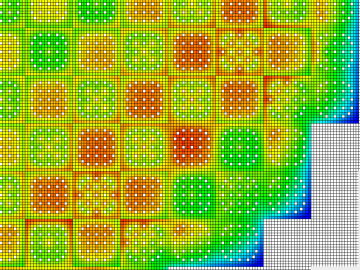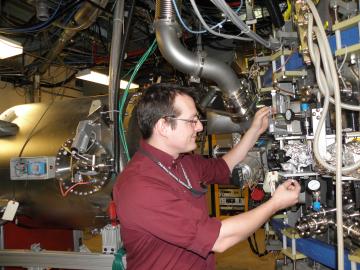
Filter News
Area of Research
- (-) Isotopes (2)
- (-) National Security (16)
- (-) Nuclear Science and Technology (28)
- (-) Supercomputing (42)
- Advanced Manufacturing (1)
- Biology and Environment (22)
- Computational Engineering (2)
- Computer Science (7)
- Electricity and Smart Grid (2)
- Energy Science (41)
- Fusion and Fission (29)
- Fusion Energy (13)
- Materials (22)
- Materials for Computing (2)
- Mathematics (1)
- Neutron Science (8)
- Nuclear Systems Modeling, Simulation and Validation (1)
- Quantum information Science (7)
- Sensors and Controls (1)
News Type
News Topics
- (-) Exascale Computing (17)
- (-) Fusion (8)
- (-) Grid (6)
- (-) Machine Learning (15)
- (-) Molten Salt (4)
- (-) Nuclear Energy (32)
- (-) Quantum Science (15)
- 3-D Printing/Advanced Manufacturing (5)
- Advanced Reactors (9)
- Artificial Intelligence (27)
- Big Data (23)
- Bioenergy (4)
- Biology (9)
- Biomedical (17)
- Biotechnology (2)
- Buildings (2)
- Chemical Sciences (2)
- Computer Science (67)
- Coronavirus (11)
- Critical Materials (3)
- Cybersecurity (9)
- Energy Storage (4)
- Environment (21)
- Frontier (18)
- High-Performance Computing (30)
- Irradiation (1)
- Isotopes (23)
- Materials (9)
- Materials Science (13)
- Mathematics (2)
- Microscopy (2)
- Nanotechnology (6)
- National Security (25)
- Neutron Science (9)
- Partnerships (1)
- Physics (5)
- Polymers (2)
- Quantum Computing (15)
- Security (8)
- Simulation (13)
- Software (1)
- Space Exploration (8)
- Summit (28)
- Transportation (5)
Media Contacts

To better understand the spread of SARS-CoV-2, the virus that causes COVID-19, Oak Ridge National Laboratory researchers have harnessed the power of supercomputers to accurately model the spike protein that binds the novel coronavirus to a human cell receptor.

East Tennessee occupies a special place in nuclear history. In 1943, the world’s first continuously operating reactor began operating on land that would become ORNL.

Radioactive isotopes power some of NASA’s best-known spacecraft. But predicting how radiation emitted from these isotopes might affect nearby materials is tricky

A developing method to gauge the occurrence of a nuclear reactor anomaly has the potential to save millions of dollars.

The inside of future nuclear fusion energy reactors will be among the harshest environments ever produced on Earth. What’s strong enough to protect the inside of a fusion reactor from plasma-produced heat fluxes akin to space shuttles reentering Earth’s atmosphere?

The Department of Energy has selected Oak Ridge National Laboratory to lead a collaboration charged with developing quantum technologies that will usher in a new era of innovation.

It’s a new type of nuclear reactor core. And the materials that will make it up are novel — products of Oak Ridge National Laboratory’s advanced materials and manufacturing technologies.

As CASL ends and transitions to VERA Users Group, ORNL looks at the history of the program and its impact on the nuclear industry.

ORNL researchers have developed an intelligent power electronic inverter platform that can connect locally sited energy resources such as solar panels, energy storage and electric vehicles and smoothly interact with the utility power grid.

Lithium, the silvery metal that powers smart phones and helps treat bipolar disorders, could also play a significant role in the worldwide effort to harvest on Earth the safe, clean and virtually limitless fusion energy that powers the sun and stars.


